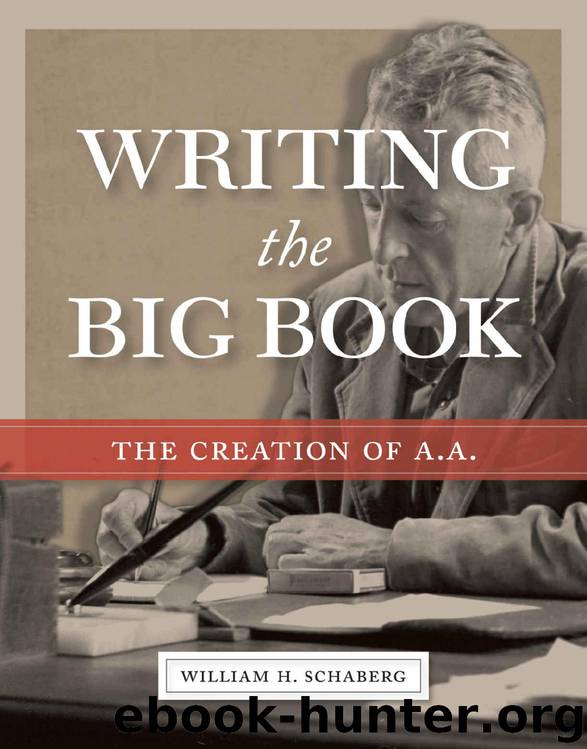Writing the Big Book: The Creation of A.A. by William H. Schaberg

Author:William H. Schaberg [Schaberg, William H.]
Language: eng
Format: epub
Tags: Biography & Autobiography, United States, Addiction, Self-Help, Psychology, 20th Century, Twelve-Step Programs, History, Psychopathology, Social Activists
ISBN: 9781949481297
Google: 3Dy5DwAAQBAJ
Amazon: B07ZMHLDCK
Publisher: Central Recovery Press
Published: 2019-09-24T00:00:00+00:00
* This low opinion of women in A.A. was, unfortunately, not confined to the 1940s nor were the wives of members the only ones who professed it. Female A.A. members could be equally harsh on their sisters in recovery. There was a front-page article published in the October 1946 issue of The A.A. Grapevine entitled “Women in A.A. Face Special Problems” written by Grace O. of Manhattan that is literally shocking to twenty-first century sensibilities. The author’s indictment of women in this long article will reward any reader seeking a better understanding of the significant prejudices and barriers blocking a woman’s path to sobriety in A.A. during the mid-1940s (and beyond).
* Sylvia Kaufman drank on the way back to Chicago, but did finally quit a few months later. Once sober, she joined forces with Earl Treat and they became the two most important and active founding members of A.A. in Chicago. Her story, “The Keys to the Kingdom” (which makes no mention of these early difficulties in Ohio), appears in the second, third, and fourth editions of Alcoholics Anonymous (starting on pages 304, 304 & 268 respectively). Fourteen years after writing her story, Sylvia wrote a postscript in a January 1969 article in the AA Grapevine entitled “Don’t Take Our Word For It.” According to member list index cards kept by the Chicago group, Sylvia’s date of sobriety was September 13, 1939, which likely makes her the first woman to achieve permanent long-term sobriety in Alcoholics Anonymous. She died on October 31, 1974.
* As the endnotes attest, most of the foregoing information on the experience of women in early A.A. comes from just a few pages of Dr. Bob and the Good Oldtimers, highlighting one of the most glaring gaps in our current understanding of the early years of Alcoholics Anonymous. It is criminal that there is still no serious and insightful study—based on thorough research using primary documents—to tell the story of women’s fight for acceptance in A.A. from 1935 to 1945. This is a truly important story and one can only hope that someday soon an able historian will take it on as a doctoral dissertation or a full-blown book-writing project. It is desperately needed.
* See the footnote on p. 190 of this book for the previous discussion of the fact that Bill Wilson never asked Anne Smith to write “To Wives.”
* I would suggest that the sentiments in this paragraph (“I still don’t know why Bill wrote it” and “I don’t think I have ever gotten over it”) provide some interesting insights into the Wilson’s marriage in relation to the levels of communication that prevailed there and to the resentments that obviously remained unresolved for decades.
* Alcoholics Anonymous (4th edition) on pp. 567–68. The other two elements are honesty and open mindedness.
* To help husband number one, “you might suggest he read this book, or at least the chapter on alcoholism.” Husband number two is to be offered a more vigorous introduction to the book: “Show him your copy of this book and tell him what you have found out about alcoholism.
Download
This site does not store any files on its server. We only index and link to content provided by other sites. Please contact the content providers to delete copyright contents if any and email us, we'll remove relevant links or contents immediately.
| Africa | Asia |
| Canadian | Europe |
| Holocaust | Latin America |
| Middle East | United States |
Fanny Burney by Claire Harman(26560)
Empire of the Sikhs by Patwant Singh(23021)
Out of India by Michael Foss(16819)
Leonardo da Vinci by Walter Isaacson(13235)
Small Great Things by Jodi Picoult(7070)
The Six Wives Of Henry VIII (WOMEN IN HISTORY) by Fraser Antonia(5455)
The Wind in My Hair by Masih Alinejad(5056)
A Higher Loyalty: Truth, Lies, and Leadership by James Comey(4905)
The Lonely City by Olivia Laing(4768)
The Crown by Robert Lacey(4761)
Millionaire: The Philanderer, Gambler, and Duelist Who Invented Modern Finance by Janet Gleeson(4420)
The Iron Duke by The Iron Duke(4319)
Papillon (English) by Henri Charrière(4227)
Sticky Fingers by Joe Hagan(4143)
Joan of Arc by Mary Gordon(4053)
Alive: The Story of the Andes Survivors by Piers Paul Read(3996)
Stalin by Stephen Kotkin(3918)
Aleister Crowley: The Biography by Tobias Churton(3605)
Ants Among Elephants by Sujatha Gidla(3440)
